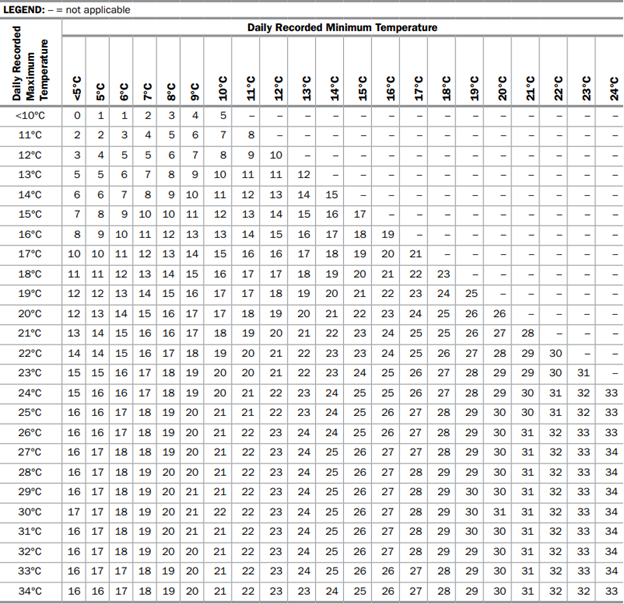Crop Heat Units (CHU) are based on a principle similar to GDD. CHU accumulations are calculated on a daily basis, using the maximum and minimum temperatures, however, the equation that is used is quite different. The CHU model uses separate calculations for maximum and minimum temperatures. The maximum or daytime relationship uses 10°C as the base temperature and 30°C as the ceiling, because warm-season crops do not develop at all when daytime temperatures fall below 10°C and develop fastest at about 30°C. The minimum or nighttime relationship uses 4.4°C as the base temperature and does not specify an optimum temperature, because nighttime minimum temperatures very seldom exceed 25°C in Ontario. The nighttime relationship is considered a linear relationship, while the daytime relationship is considered non-linear because crop development peaks at 30°C and begins to decline at higher temperatures. Daily CHU are calculated by using the average of the two daily values from the equations below or can be read from the matrix in Table 10–4, Daily crop heat unit accumulations based on maximum and minimum temperatures.
Producers who record high and low temperatures can use Table 10–4, Daily crop heat unit accumulations based on maximum and minimum temperatures, to calculate CHU accumulations for their own farm. CHU accumulations are recorded from May 1st at all locations and end with the first occurrence of -2°C in the fall. Corn development is driven primarily by temperature, and this is especially true during the planting-to-silking period. Unlike soybeans, day length has little effect on the rate at which corn develops. The Ontario CHU system has been developed to calculate the impact of temperature on corn development.
CHU accumulation affects soybeans differently than corn. Soybeans, a warm-season crop, are more susceptible to cold temperatures, especially during flowering. It is believed that sustained cold temperatures (less than 10°C) during flowering affect proper formation of pollen in the flower. Sustained cold temperatures result in poorly developed pods called parthenocarpic pods (also called “monkey pods”). There is some variety difference in tolerance to cold temperatures.
Table 10–4. Daily crop heat unit accumulations based on maximum and minimum temperatures

Calculating Daily CHU
The following equation is used to calculate a daily CHU for a site:
Daily CHU = (Y max + Y min) ÷ 2 where:
Y max = (3.33 x (T max–10)) – (0.084 x (T max–10)2) (If values are negative, set to 0) T max = Daily maximum air temperature (°C) (measured from midnight to midnight) (Accuracy should be <0.25°C)
Y min = (1.8 x (T min – 4.4))
(If values are negative, set to 0)
T min = Daily minimum temperature (°C)